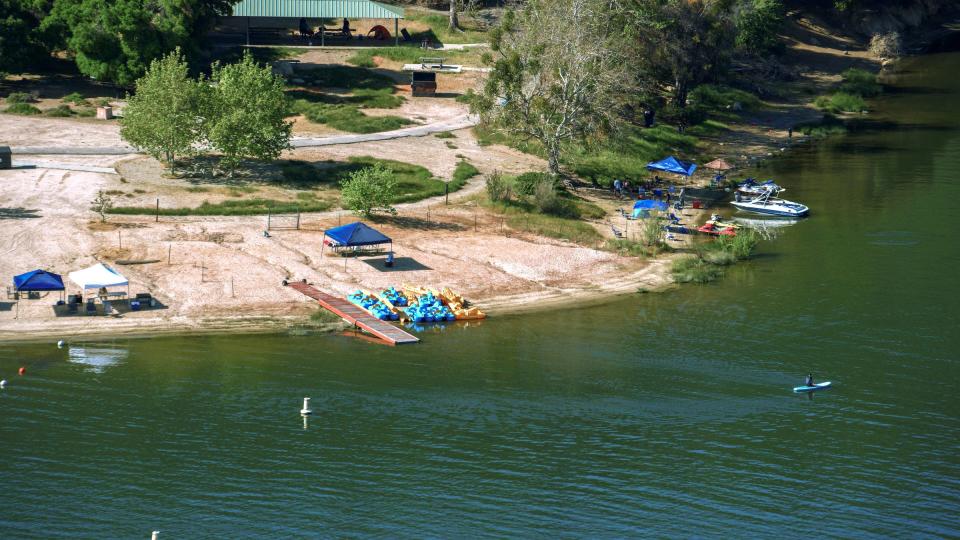California water officials have issued a “toxic algal bloom” warning, telling people to stay away from Lake Silverwood until further notice.
Blue-green algae blooms, a natural part of the ecosystem, can produce toxins that can make people and animals sick, according to the California Department of Water Resources.

Silverwood Lake State Recreation Area
Silverwood Lake officials said the California Department of Water Resources notified state parks that harmful algae may be present, prompting a caution level alert to protect the health and safety of park visitors and pets.
“Although swimming is permitted in the lake, visitors are advised to stay away from algae and foam in the water or on the shore,” Silverwood Lake officials said. “Do not let pets or other animals enter or drink water or eat scum on the shore.”
A copper sulfate treatment was scheduled for Tuesday, May 7, to control the bloom.
California Department of Water Resources
Bloom conditions can change quickly and wind and waves can move or concentrate blooms in different regions of a reservoir. Algal blooms can vary in characteristics, from a variety of textures to colors, state officials said.
The state regularly monitors and tests water from the California State Water Project for algal toxins. When tests are positive, confirming the presence of a harmful algal bloom, warnings are posted on site, at the reservoir and online.
Once toxins are found, testing continues, and health warnings and recommended precautions are not reduced until laboratory results show that the algae are declining and toxin levels are below the level of concern two weeks ago.
The state encourages recreational users, such as swimmers and boaters, to take necessary precautions and stay away from algae at all times.
There is no sure way to tell if an algae bloom is toxic just by looking at it, but there are indicators that an algae bloom can be harmful.
Signs of Harmful Algal Blooms
-
Small blue-green, green, white or brown particles in the water
-
Streaks in the water that look like spilled paint
-
Mats, foam or scum on the surface or along the shore
-
May have an odor described as gasoline, septic or fishy
Algae Dangers
-
Some algal blooms can produce toxins that are harmful to people and pets.
-
Dogs and young children are more likely to be affected by the bloom due to their smaller body size and likelihood of playing in the water for longer periods.
-
Animals can be especially susceptible to toxins because they tend to drink while in the water and then lick their fur.
-
Exposure to toxic cyanobacteria can cause eye, nose, mouth or throat irritation, headache, allergic rash, mouth ulcers, vomiting, diarrhea and cold- and flu-like symptoms.
How to be exposed to algae toxins
-
People can be exposed to toxins during swimming or other water-contact activities and when they accidentally swallow lake water.
-
During water skiing and jet skiing, toxins can become airborne in the water spray and be inhaled
-
People can also be exposed to toxins by eating shellfish and fish from affected bodies of water.
-
Dogs or other animals can become sick if they eat foam or mats in the water or on the shore, drink water or lick their fur after being in the water.
Precautions to take
-
Follow all posted notices
-
Stay away from algae and debris in the water and on land
-
Watch children and pets closely
-
Do not let pets and other animals enter the water, drink water, or eat scum and algae build-ups on the shore
-
Do not drink the water or use it for cooking
-
Wash yourself, your family and your pets with clean water after playing in the water
-
If you catch fish, discard the guts and clean the fillets with tap water or mineral water before cooking.
-
Avoid eating shellfish from affected areas
Daily Press reporter Rene Ray De La Cruz can be reached at RDeLaCruz@VVDailyPress.com. Follow him on X @DP_ReneDeLaCruz
This article originally appeared in the Victorville Daily Press: State officials warn visitors to avoid Lake Silverwood due to algae






































